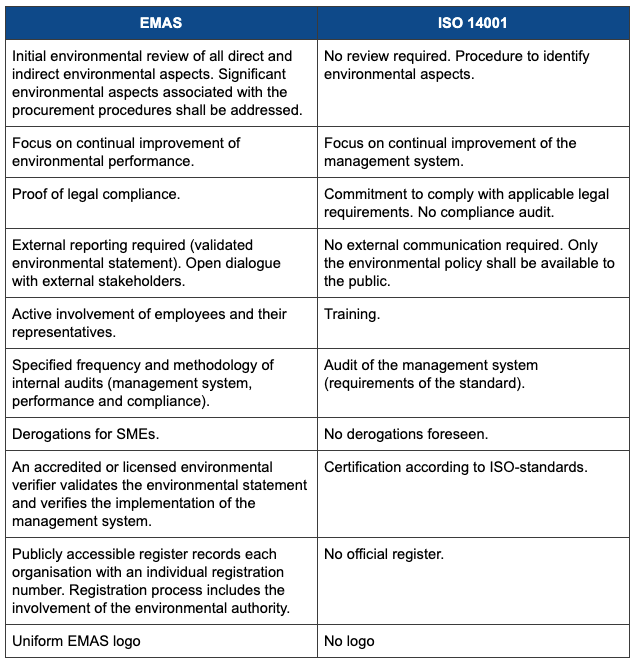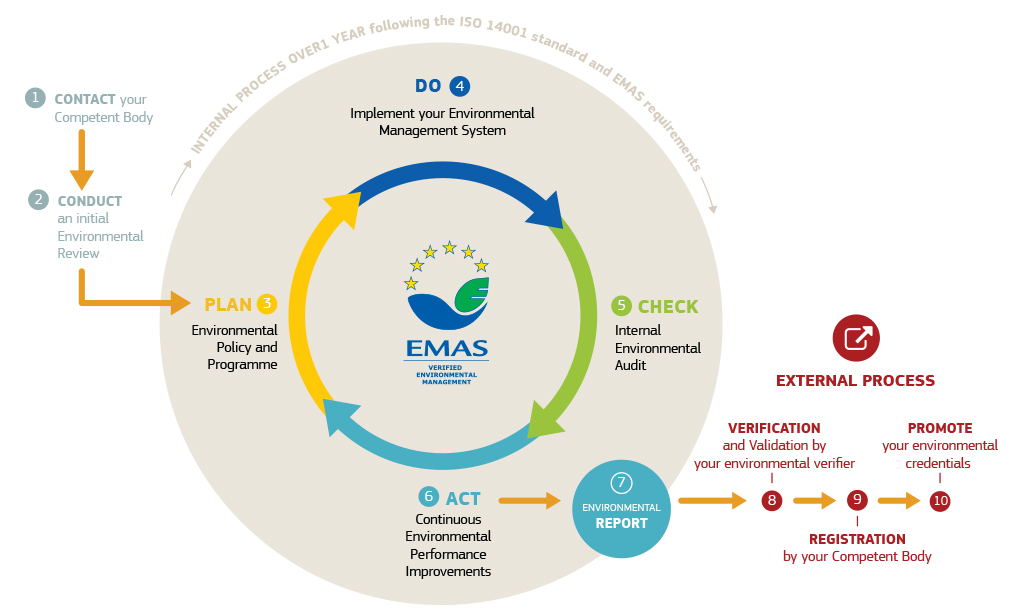Have you heard of EMAS Certification? It is an environmental management and audit tool created by the European Commission, which any type of organisation can use to improve its environmental performance.
If your organisation is looking to obtain this certification, learn more about it: how to get it, how it differs from ISO 14001, and how efficient energy management will help you to obtain it.
What is EMAS Certification (Eco-Management and Audit Scheme)?
The climate emergency in which we find ourselves has forced governmental organisations to create regulations and legislation that are more and more demanding in terms of environmental protection. In addition, society’s increased awareness of the environment makes these demands even more evident.
Consequently, any organisation needs to have global environmental management strategies in place. This makes the use of environmental management standards such as EMAS or ISO 14001 increasingly common among companies.
What is known as EMAS certification is an international, voluntary European Eco-Management and Audit Scheme (EMAS), which allows organisations to assess, report and improve their environmental performance. And although it was created for European-wide recognition, after its revision in 2010, EMAS registration is possible for any organisation worldwide.
But before we continue talking about EMAS, let’s take a moment to review another well-known environmental management standard, ISO 14001.
The ISO 14001 standard aims to help companies implement an Environmental Management System (EMS) that allows them to identify and manage environmental risks as a consequence of their activity.
An important feature of this ISO is the application of the PDCA (Plan, Do, Check, Act) methodology, which is followed by most ISO standards. In addition, because it has concepts, structures and terminology common to other ISO standards of different scopes, the fact that your organisation already has some ISO certification makes it easier to implement others.
For example, if your company already has ISO 50001, which certifies the implementation of an energy management system, it will make it easier to obtain ISO 14001.
Commonly, many organisations that already have ISO 14001 want to obtain the EMAS certificate as well. On the one hand, if your organisation already has this ISO it will be easier to comply with the requirements of the EMAS Regulation, as they are based on the same PDCA (Plan, Do, Check, Act) methodology. And on the other hand, the EMAS certificate has a higher image of excellence.
And what is the difference between EMAS and ISO 14001?
One of the main differences between EMAS and ISO 14001 is that, to be part of the EMAS registered organisations, an environmental statement is required, which must be validated by an external verifier annually, which makes it more demanding. ISO, on the other hand, does not require this periodic review.
The 10 Steps to EMAS Certification
Obtaining EMAS certification is based on 10 steps and the 4 key principles “Plan, Do, Check and Act”:
Find out the 10 Steps to EMAS Certification and How Energy Efficiency can Help you
1. Contact your competent authority. The first step of all to becoming EMAS registered is to contact your local competent authority. They will provide you with all the information, technical support and even information on what funding options are available to you.
2. Carry out an environmental audit of your organisation. This step is necessary to identify the most significant environmental problems caused by your organisation’s activities. It will also help you establish benchmarks against which to measure future success in reducing your impact.
3. Plan the environmental policy and programme to be followed. In other words, you will need to define the structure of your Environmental Management System (EMS). Here we recommend that you have an expert in the field.
4. Implement your Environmental Management System. This step will take some time in your organisation, but planning ahead will make it much easier.
5. Check the effectiveness of the implemented Environmental Management System by internal audit. Once the EMS has been implemented you will need to monitor the processes to evaluate the results. In this way, you will be able to control the main indicators required by EMAS, which you will later need in the environmental report that your organisation must deliver for external validation.
On the other hand, this monitoring step will allow your organisation to detect deviations in the indicators and the targets set for each one. Giving the opportunity to take corrective actions in advance.
6. Act to achieve continuous improvement of the organisation’s environmental performance. EMAS encourages continual improvement, a process in which errors are identified, documented and analysed to eliminate their direct and indirect causes. This step is therefore essential to comply with the Regulation.
7. Create the final Environmental Report. In this report your organisation should describe its EMS and summarise its environmental achievements, detailing both past and future actions.
In addition, it should include data from the indicators set out in the EMAS annexes. In particular, you should pay attention to indicators in 6 key areas:
- Energy efficiency: total direct energy use, including renewable energy use
- Material efficiency: the annual mass flow of the different materials used
- Water: total annual water consumption
- Waste: total annual (hazardous) waste generation
- Biodiversity: land use
- Emissions: total annual greenhouse gas emissions and total annual air emissions
8. Verify and validate your EMS. This process must be carried out by an independent environmental verifier, accredited or licensed by an EMAS authority, to whom you must deliver the environmental report you previously created.
The external verifier will examine your report, visit your organisation and interview staff to validate that your organisation complies with the requirements set out in the Regulation.
9. Application for EMAS registration. Once your EMS and environmental report (environmental statement) have been formally verified and validated, you must apply to the local competent body for the registration of your organisation, which will register your organisation in the European EMAS register. Congratulations, you are now an EMAS organisation!
10. And as a last step, promote your organisation’s EMAS credentials. Now you can use the EMAS logo in your communications and designs to showcase your international good environmental practice certification. In addition, your EMAS certification can be checked by any external party, as the register is public and accessible to anyone.
If you have any questions about the EMAS Regulation, we recommend you take a look at the Q&A section available on the official website of the European Commission about the certificate.
How Dexma can help you to obtain your EMAS Certification
During the planning and implementation of your Environmental Management System (EMS), you will need, among other things, to know in detail everything related to the energy performance of your organisation: consumption, costs, impact on greenhouse gas emissions, implementation of energy saving and efficiency measures to be carried out, etc.
The key here is to have a specialised and efficient energy management system. In addition, to work with professional experts in energy management, either in-house or outsourced.
If in the case of your organisation, you have a team responsible for energy management, you probably already have this area under control.
At Dexma we are experts in energy management solutions, in other words, in key tools that support energy experts in their energy efficiency projects.
With the use of an Advanced Energy Management Platform such as Dexma your energy management team will be able to obtain all the data mentioned above (consumption, costs, impact on greenhouse gas emissions, implementation of energy saving and efficiency measures to be carried out, …), which will allow you to obtain the indicators required in the key area of ENERGY EFFICIENCY, as well as to plan an energy efficiency project with which to achieve and implement energy improvements.
If you want to know more about all the potential that offers the Dexma Platform to your energy department and the annual compliance of the EMAS certificate, contact one of our experts in energy management software and request your personalised demo.






